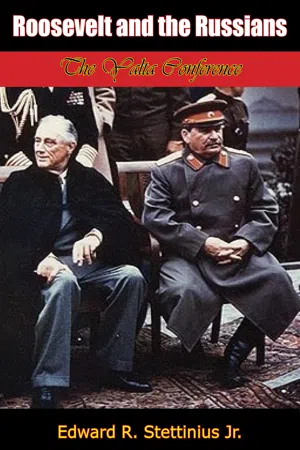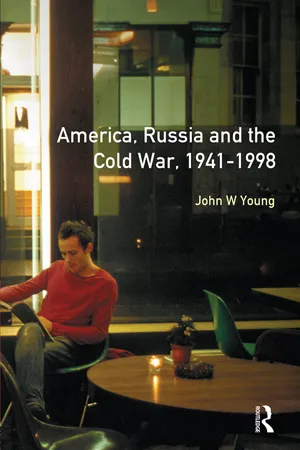History
Wartime Conferences
Wartime conferences were pivotal meetings held during World War II among the Allied leaders to strategize and coordinate military efforts. Key conferences included the Tehran Conference, Yalta Conference, and Potsdam Conference, where decisions were made regarding the post-war world order, including the division of Germany and the establishment of the United Nations. These conferences played a crucial role in shaping the outcome of the war and its aftermath.
Written by Perlego with AI-assistance
Related key terms
2 Key excerpts on "Wartime Conferences"
- eBook - ePub
Roosevelt and the Russians
The Yalta Conference
- Edward R. Stettinius Jr.(Author)
- 2017(Publication Date)
- Eschenburg Press(Publisher)
The Yalta Conference, too, was the first real occasion on which the Chiefs of Staff of the three countries conducted an exhaustive examination of the respective military positions of the Allied forces and discussed in detail their future plans. The timing of the second front and related military questions had been discussed at Teheran, but it was not until Yalta that sufficient confidence existed among the three nations for a free and open examination of future operational plans.Thus the Yalta Conference marked the high tide of British, Russian, and American co-operation on the war and on the post-war settlement. In the days immediately after the Conference most American newspapers gave high praise to what had been accomplished in the Crimea.On February 13, 1945, the New York Times wrote:The alliance of the Big Three stands firm. Progress has been made. The hope of further gains is high. This conference marks a milestone on the road to victory and peace.The long and detailed agreements announced at the end of the second conference between President Roosevelt, Prime Minister Churchill and Marshal Stalin and now submitted to the judgment of the world are so broad and sweeping that it will take a detailed analysis and a demonstration of their application in actual practice to measure their full scope and final implications. But even the first glance gives assurance that, though they may disappoint some individual expectations, they justify and surpass most of the hopes placed on this fateful meeting, and in their aims and purposes they show the way to an early victory in Europe, to a secure peace, and to a brighter world....The New York Herald Tribune called the Yalta communiqué a “remarkable document.” “The overriding fact,” this paper observed, “is that the conference has produced another great proof of allied unity, strength and power of decision.” The Philadelphia Record termed the Conference the “greatest United Nations victory of this war.”Congressional leaders like Senators Barkley, Vandenberg, White, Kilgore, and Connally praised the results of the meeting. A survey of public reaction, conducted for the State Department during the last week of February, revealed that the American people considered the Yalta Conference a success. This survey reported that the Conference had raised hopes for a long-time peace; it had increased satisfaction with the way the Big Three were co-operating, and with the way the President and the State Department were handling American interests abroad. - John W. Young(Author)
- 2014(Publication Date)
- Routledge(Publisher)
Section Three Conferences and Summits The following includes summaries of all US–Soviet Summits, plus other major Cold War conferences, and an outline of US–Russian Summits after the Cold War. 1. Tehran Summit, 28 November–1 December 1943The Tehran Summit marked the first ‘Big Three’ leaders’ meeting. Roosevelt had long wanted such a conference but Stalin had been reluctant to meet Churchill and Roosevelt until the Red Army had put the Wehrmacht on the defensive. Following the battles of Stalingrad and Kursk he felt more confident, but insisted on a meeting close to the Soviet border. With Anglo-American forces victorious in North Africa, all three Allies could plan more confidently for the war against Germany. The Soviets, critical in the past of the failure to open a ‘Second Front’ against Germany, were now promised an Anglo-American landing in France in 1944. Stalin pleased the US by promising that he would enter the Far Eastern war in due course. Political issues took second place to military ones at Tehran but a discussion was held on the control of Germany in future and Roosevelt put forward his ideas on a United Nations organisation under the auspices of the ‘four policemen’ (the Big Three, plus China).2. Yalta Summit, 4–12 February 1945The second ‘Big Three’ Summit was held when, with victory assured, post-war political issues had to be addressed. The name Yalta later became a byword for the West’s betrayal of Eastern Europe, which fell under Soviet domination. But at the time, the Conference seemed a success and, contrary to popular mythology, it did not
Learn about this page
Index pages curate the most relevant extracts from our library of academic textbooks. They’ve been created using an in-house natural language model (NLM), each adding context and meaning to key research topics.

